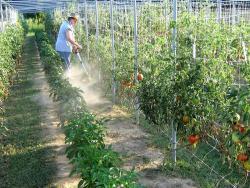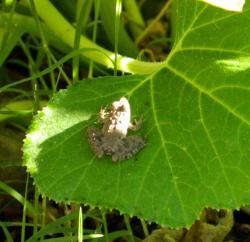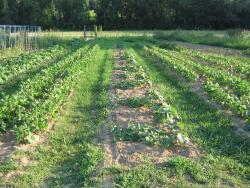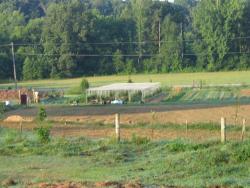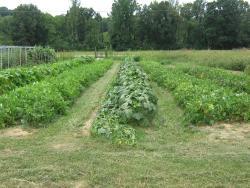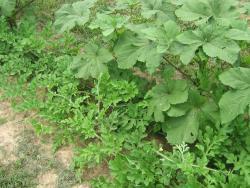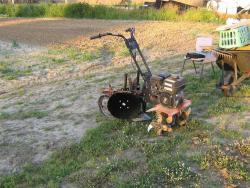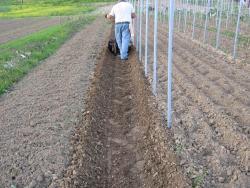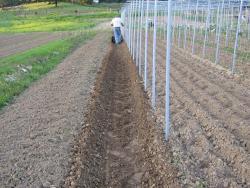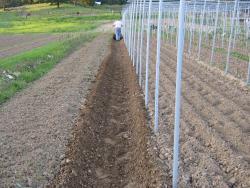The last week in July of 2013, we had a bad storm and it must have rained leaf footed bugs because the next day I had a plague of them in the garden. Thousands and thousands overnight.
Since I don't use insecticides, I decided to treat it as a blessing and use their abundance as an opportunity to learn how to control them without poison.
This is a row of Rattlesnake pole beans. There wasn't a single stink bug or leaf-footed bug on them. Same for cucumber beatles. The row to the left of the picture is Purple Eye Purple Hull peas (they have a better flavor than the common Pink Eye Purple Hull peas) and has thousands of squash bugs, leaf-footed bugs and cucumber beatles. They like to drink the nectar the peas provide where the pea pods join the stem.
I planted the row of peas on a 4' wide bed with tomatoes as an experiment to see if the tomatoes or peas were effected by each other. I also planted another double row on a different bed away from the tomatoes. I had never seen Purple Hull peas put out runners. The double row I planted away from the tomatoes didn't make any runners. Same seed. The rows run north and south. The distance from the peas to the trellises was the same east and west, but the peas didn't put out a single runner trying to get to the east trellis. They all ran to the west trellis and grew to the top of the 6' trellis and then back down to the ground. The single row of peas next to the tomatoes produced 3 times as many peas as the double row away from the tomatoes and were still setting peas when frost took them out. The peas weren't damaged by the stink bugs, but the tomatoes were a total loss. It didn't matter about the tomatoes, because the stink bugs also destroyed all the other rows of tomatoes and peppers. They do like to suck the fruit don't they.
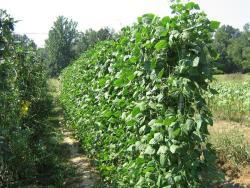
This is an earlier photo taken shortly after the beans were planted. What you see at the far end of the bean row is Boston Pickling cucumber. I planted a third of the bed in a double row of cucumbers and 2/3 of the row in a double row of beans. The reason the beans are so far behind the cucumbers is I had to replant the beans. I used seed saved from the prior year (Romas) and 2 seed had sprouted in 2 weeks. Used fresh seed to replant and got a 100% stand. 2 seed every 10" thinned to best one on the cucumbers, no thinning on the beans. The beans had no deterrent effect on the stink bugs as far as keeping them off the cucumbers, peas or tomatoes. Fortunately the cucumbers were almost finished producing before the plague arrived.
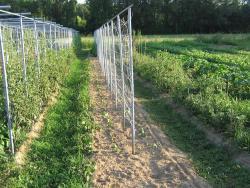
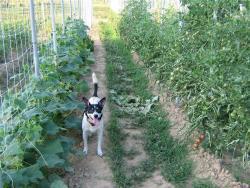
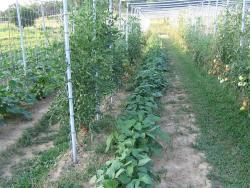
This is the double row of peas planted away from the tomatoes. Next to the peas is a row of Early Long Purple eggplant with a row of Fordhook Improved lima beans on both sides of the eggplant. The limas were supposed to keep Potato beatles off the eggplant. And it is 100% effective. Same for flea beatles. But it only becomes effective when the lima vines are about 8 - 10 inches tall. I had to hand pick the beatles until the limas kicked in. When I harvested the limas I made a tea from the hulls and vines. I'm saving the tea to spray on the eggplant this spring to see if it is as effective as the live plant (smells just like lima bean vines). I planted some eggplant on the next row without lima beans and the limas protected that row also, so limas will provide protection from Potato beatles and flea beatles for at least 6' from where they are planted.

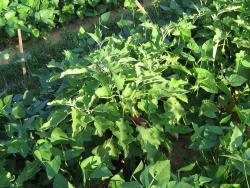
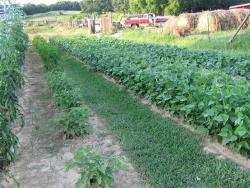
Hope we see lots of this this year.
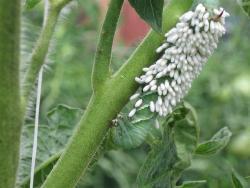
And the rotary hoe and the rotary hoer. Claud
